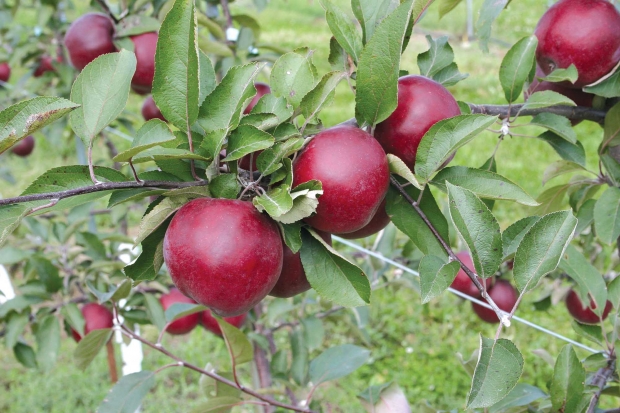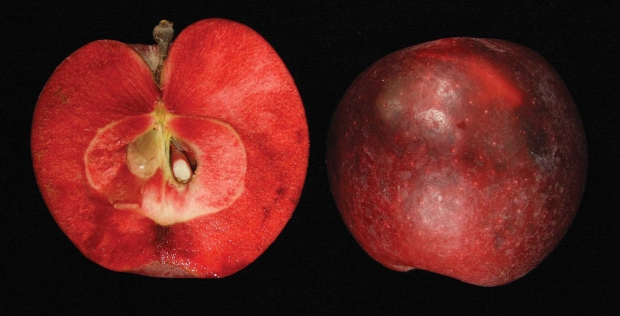
The Otterson cultivar has good size and yield, some resistance to diseases, and most importantly, deep red skin and flesh. (Courtesy Steve Van Nocker)
You may not have heard of an apple called the Otterson, but it’s looking good in a small planting at the Michigan State University fruit research station in Clarksville, Michigan.
It was put there at the direction of Dr. Steve Van Nocker, a plant geneticist in MSU’s horticulture department, who has a planting of 10 to 50 trees each of 10 cultivars that share one characteristic: red flesh.
“The Otterson fruit is about the size of a Michigan Red Delicious (not huge), but it has huge yield and nice color,” he said. “It’s deep red all the way through and shows little leaf damage or defoliation. I’m very happy with it.”
In an interview with Good Fruit Grower, Van Nocker didn’t say whether it tasted good or not. Taste isn’t really important for what he wants to do.
He wants to find apples that contain large amounts of anthocyanins, part of a group of compounds called flavonoids. Anthocyanins give redness, blueness, or purpleness to fruits such as cherries, apples, and blueberries. Van Nocker thinks a commercial industry can be built using red apples as a source of anthocyanins, which could be extracted and used as natural food colorants or sold in capsules as a dietary supplement.
“The strength of the scientific evidence for health-beneficial effects of flavonoids in humans is debated, but the public perception is that they are highly beneficial to human health,” he said. Anthocyanins are thought to be powerful antioxidants, able to cleanse a body of free radicals that cause cell damage, aging, strokes, heart disease, and cancer.
Apples produce large yields compared to cherries or berries. Van Nocker envisions that orchards of a variety, like perhaps Otterson, could be grown without much input expense, harvested mechanically with shakers as tart cherries are now, and processed in factories to remove this powerful red colorant. In apples with red pigment, anthocyanins comprise about one part in a thousand, fresh weight basis, or about an ounce in a bushel and a half of apples.
“These compounds are powerful antioxidants in vitro, and are widely believed to contribute to human health,” he wrote in a paper published in 2012 in the journal Euphytica. “Red-fleshed apple genotypes are an attractive starting point for development of novel varieties for consumption and nutraceutical use through traditional breeding and biotechnology.”
Red-fleshed cultivar development has been limited, he said, because apple breeders don’t really know what they should choose as parents in the breeding process.
So, in 2009 and 2010, Van Nocker and several colleagues began a process of cataloguing the apples—almost 6,000—found in four collections. They did DNA tests on each one that showed redness in the flesh or foliage and published the results for plant breeders to use. His paper is available in .pdf format under his name on the Web site www.hrt.msu.edu.
The collections include the U.S. Department of Agriculture’s germplasm collection in Geneva, New York, which has 2,289 accessions; the Canadian Clonal Genebank in Harrow, Ontario, with about 2,200 accessions; the National Fruit Collection in Brogdale, Kent, United Kingdom; and the Michigan State University collection in East Lansing, containing 1,263 trees.
Interestingly, the MSU collection is scattered widely across the 5,000-acre campus, where many are planted as ornamental landscape trees. Red-fleshed apple trees usually have deep red flowers, instead of pink or white, and red or purple foliage. Fruit is usually small, hangs well into the winter, and is considered wildlife food.
Pucker power
Van Nocker notes, however, that the genes that make fruit deep red may make it astringent—giving it pucker power that isn’t much appreciated. It has made breeding of red-fleshed, fresh-eating apples difficult. “It may be the compound itself that doesn’t taste very good,” he said.
The studies showed that the major gene for red flesh color in almost all the trees could be traced back to one central Asian ancestor, Malus pumila var. niedzwetzkyana. However, an apple named Pink Pearl, which is yellow-skinned but with red pigmentation mixed with white inside, has distinctly different genes from the others.
The genetics of redness are not simple, however. Additional genes are involved, and trees can have one or two copies of each. Apples can be thoroughly red throughout, as in Otterson and many crab apples, or mildly tinged with red tints or streaks, and they can be deeper red near the skin or near the core and whiter elsewhere.
Redness in most varieties was associated with an allele of the MdMYB10 gene, named MdMYB10-R6, discovered by scientists in New Zealand in a cultivar called Redflesh. Many times, redness occurs in the skin but not the flesh. In some cultivars, the genes don’t seem to function.
While the allele R6 is thought to be the original ancient central Asian mutation that gives redness to most apples, the Pink Pearl apple contains R1 only but is strongly colored internally.
Foliage
In the study, the researchers cut apples, and, if redness was found, they described the pigmentation intensity and pattern in their paper. They also examined all accessions that showed red-tinged or purplish foliage. They concluded that this genetic diversity should be exploited to make informed crosses generating new cultivars with superior qualities for commercial nutraceutical production.
Van Nocker is not a plant breeder himself. His major interest is in basic genetics. He’s studying how plants flower in response to environmental factors such as cold temperature and how it is that cloning allows transmission of “adult” features, such as flowering.
As a hobby, he makes juice from red apples and ferments it into hard cider. The astringent qualities of red apples are more appreciated in juice and cider than they are in fresh apples, he said, and the juice is very attractive. •

The Otterson cultivar has good size and yield, some resistance to diseases, and most importantly, deep red skin and flesh.(Courtesy Steve Van Nocker)






This article prompts an interest in grafting Otterson apple to my home orchard; have fund a source for 2020. I already have Winekist & Redfield. Winekist is little known in comparison to Redfield, ripens 20-30 July in Spokane, WA. It is red throughout in our high sun, 11 or 12 Brix, quite tart & astringent. Might be a candidate for this study.